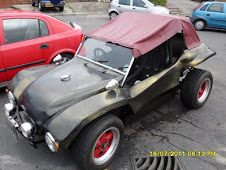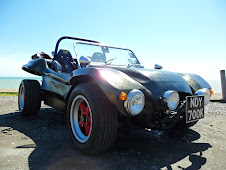 14th June 2009
14th June 2009With the disaster of my engine case I had to find a company that could weld and re tap the oil gantry. This was a difficult task and in the meantime I turned my attention to the other parts of the engine that needed cleaning up. I had two companies that I had approached to do the case work but both were taking time to come back to me.
Originally I had thought that I would just cut weld and chop of the air outlets from the fan housing but a friend had put a thread on Volkszone about this and surprisingly there had been some technical testing done by Jake Raby's research into engine temperatures and fan housing design. That indicated that the Fan housing design was constructed to have integral vanes that directed the air flow inside the housing separating air flow from the engine and diverting it to the housing outlets. It appeared from the discussions that the general consensus including my own that simply blocking of the vents would cause air flow turbulence in the coursing that would effect the fan housings overall ability to cool the engine.
I have included a picture of the internals of the VW fan housing courtesy of www.offroad.net
 which is also a source for the information here in comparison. The scat housing picture courtesy www.newlancsvwclub.co.uk is definitely missing some of the internal vanes and although seems to produce adequate cooling there must be reasons why VW includ
which is also a source for the information here in comparison. The scat housing picture courtesy www.newlancsvwclub.co.uk is definitely missing some of the internal vanes and although seems to produce adequate cooling there must be reasons why VW includ ed the extra vanes in the first place. The solution suggested by newlancsvwclub seemed to be to cut the whole outer edge of the fan housing down to remove the a
ed the extra vanes in the first place. The solution suggested by newlancsvwclub seemed to be to cut the whole outer edge of the fan housing down to remove the a ir channel that would cause the air buffer. This in practise was a very easy option and the rough shape can be seen on the following picture. The internal structure of the fan housing that directs the air to the vents can be un tacked from the fan housing and pulled out to make a new curve that follows the new line of the housing as detailed by the green line.
ir channel that would cause the air buffer. This in practise was a very easy option and the rough shape can be seen on the following picture. The internal structure of the fan housing that directs the air to the vents can be un tacked from the fan housing and pulled out to make a new curve that follows the new line of the housing as detailed by the green line.I started on my fan housing removing first the air outlets with an angle grinder and thin cutting disk. The outlets came of fairly easily and from the holes that were left I was able to see the internal vane that was going to become the out
.jpg) side of the new housing. It is important to leave about 2" of metal at the top of the housing to keep the two halves held together in the correct alignment. With a flexible ruler I marked a line on the outside of the housing. With one side cut away the front side could be trimmed to ensure it was closer to to the vane. The rear section was then cut away and the vane pulled out to meet the new curve. It c
side of the new housing. It is important to leave about 2" of metal at the top of the housing to keep the two halves held together in the correct alignment. With a flexible ruler I marked a line on the outside of the housing. With one side cut away the front side could be trimmed to ensure it was closer to to the vane. The rear section was then cut away and the vane pulled out to meet the new curve. It c.jpg) an be seen from the picture that the vanes do not meet the top of the fan housing. I cut pieces from the cutoffs to make material to fill these gaps. Obviously you could bend the internal vanes to make any new shape you desired, however I was attempting to get the best cooling possible from the design and though that the curved top lended itself to this application.
an be seen from the picture that the vanes do not meet the top of the fan housing. I cut pieces from the cutoffs to make material to fill these gaps. Obviously you could bend the internal vanes to make any new shape you desired, however I was attempting to get the best cooling possible from the design and though that the curved top lended itself to this application. With the design and metal work cut and established the fan housing needed to be welded up . This is not as easy as it looks as the thin tin ware is quite thin. I used a MiG welder to tack up the housing at opposing points around its perimeter . This gave the construction a better stiffness that al
With the design and metal work cut and established the fan housing needed to be welded up . This is not as easy as it looks as the thin tin ware is quite thin. I used a MiG welder to tack up the housing at opposing points around its perimeter . This gave the construction a better stiffness that al lowed the perimeter to be tacked up. The result of he welding process is not as neat as the original design and it as obvious that I would need to prep the housing before painting. After Angle grinding the surplus weld of the housing I decided to try p38 filler to smooth the outline.
lowed the perimeter to be tacked up. The result of he welding process is not as neat as the original design and it as obvious that I would need to prep the housing before painting. After Angle grinding the surplus weld of the housing I decided to try p38 filler to smooth the outline.  Discussions with a friend regarding this pointed out that the files likely to chip off from the housing during its use and that I would be better to have the outside prepared by fibre glass. I took the fan housing to a Friend Ash who created a mold from the housing and re profiled it to make a better curve. This was then bonded on and the whole housing was painted and primered. I painted the rest of the tin wear in
Discussions with a friend regarding this pointed out that the files likely to chip off from the housing during its use and that I would be better to have the outside prepared by fibre glass. I took the fan housing to a Friend Ash who created a mold from the housing and re profiled it to make a better curve. This was then bonded on and the whole housing was painted and primered. I painted the rest of the tin wear in  primer and needed to get a nice cool day to buy some 2pac in spray cans so that all the tin wear could be blacked up . The tin ware was looking excellent and I needed now to get the case repaired. This was looking very interesting as most posts found on Volkszone said it was a potrntial arsonists or pyrotechnics dream come true as the Magnesium base AS41 case just would turn into a large roman candle. Was it going to be possible or was I just going to have to purchase another case or complete engine?
primer and needed to get a nice cool day to buy some 2pac in spray cans so that all the tin wear could be blacked up . The tin ware was looking excellent and I needed now to get the case repaired. This was looking very interesting as most posts found on Volkszone said it was a potrntial arsonists or pyrotechnics dream come true as the Magnesium base AS41 case just would turn into a large roman candle. Was it going to be possible or was I just going to have to purchase another case or complete engine?Some pictures courtesy of www.newlancsvwclub.co.u and www.offroad.net.






















No comments:
Post a Comment